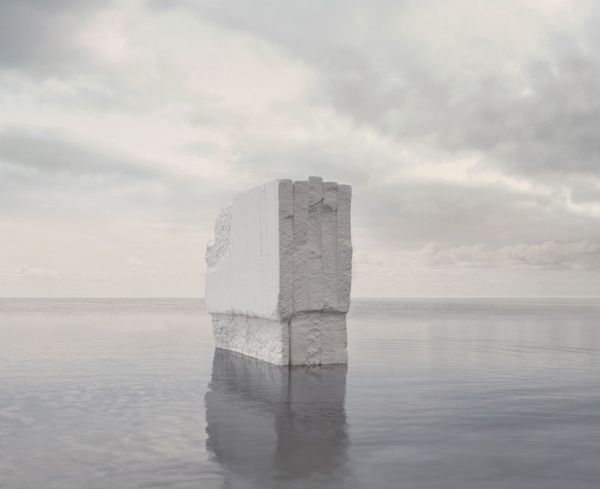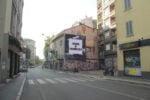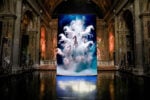Noemie Goudal – Haven her body was

Mostra personale
Comunicato stampa
Text by Sebastian Montabonel and Emma Lewis
‘The Sea is back there, back in the reservoir of memory. The sea is a myth. There never was a sea.’
Layering oppositional meanings and materials within the photographic frame, Noémie Goudal weaves truth and fiction to craft gateways into ‘make-believe’ worlds; secluded, isolated spaces that as a point of departure to examine the state and flux of the relationship between photography, memory and truth.
In the early life of the medium was a certain faith in synchronicity between the three: a presupposition of continuity between real, lived experience and its manifestation that saw the photograph as document and testimony, a physical imprint of memory. Now; post-medium, post-photography, post-internet (a state where the contemporary condition is defined by what is once was, but is no longer) the notion of total objectivity is largely accepted as a quaint impossibility. In its place, we have shifted towards an attitude that Alan Trachtenberg, writing on the relationship between photography and cultural memory, describes as a “post-Enlightenment suspicion that ‘reality’ is made up, a construction, not something secure for a camera to confirm” in which “the camera is part of the game, not to be trusted as a guide to anything but itself.” Yet while there is no doubt that this attitude of self-conscious consumption holds true, the ontology of the medium is such that our eyes read the image as fact, even if we know that we are seeing is not true. Authenticity lies in experience of what is signified, if not the sign itself. André Bazin’s statement that “photography ranks highly in the order of surrealist creativity because it produces an image that is a reality of nature, namely an hallucination that is also a fact” highlights this unique and privileged position that the photograph occupies between the real and the imagined when it is, by definition, “freed from the conditions of time and space that govern it.” It is here, between hallucination and fact, where Goudal’s practice resides.
As the etymology of the series title suggests, in Haven Her Body Was Goudal adopts an authorial mode that creates meaning through reconfiguring accepted (and expected) forms and conventions. Developing her interest in the tension between contrasting materials seen in the earlier series Les Amants, Goudal continues to build tension through the opposition of man-made vs. the organic, bringing reality and representation into close proximity by inserting her own large-scale photographs (which she describes as backdrops) into contrasting environments. Material qualities are key - the wildness of the natural and organic at odds with the hard, unyielding textures of the man-made and artificial. Whether a natural paradise within a run-down industrial setting or its inverse - a modernist doorway, symbolic of utopian ideology, posited within an untamed wilderness - the backdrops suggest an escape from the setting in which they hang, possibility inherent in sheer otherness.
Just as a tension is created between the man-made and the organic, layering images in this way creates a tension between past and present to construct what Walter Benjamin termed the ‘dialectical image’. Here, close proximity of fiction and reality create a so-called “constellation of the past and present”, a hyper-reality that when interrupted by tell-tale visual cues induces a “lighting flash of cognition” between awareness of looking at, and psychological immersion into, the frame. This moment is key, for although the practice of fabricating the subject is as almost as old as the medium itself – the 1917 photographs of the Cottingley fairies being a notorious example – inducing a consciousness of this fact marks a critical shift in claim of the image, from document to critique. Looking to El Lissitzky’s Runner in the City as a case in point, Yasufumi Nakaimori has discussed the construction of the dialectical image in 1920s Constructivist photomontage, where utopian imagery was laced with the dystopian in an act of ideological construction, and truth gleaned between the deliberate lack of reconcile between the two. Observing that “characterised variously as fragmented, divided, hegemonic, simultaneous, and hybrid, modern life is analogous to a montage” it is a method that befits a culture in which the virtual is constantly interrupting and overtaking the real. Though Goudal’s is a more self-reflexive line of enquiry, interested in the dialectical image as means of dismantling the truth-value of photography itself as opposed to broader political ideologies, it shares this mode of teasing out meaning through the fissures between contrasting or conflicting elements. From the vantage point of heightened consciousness that the dialectic provokes, we are implored to examine our interaction with, and acceptance of, the image.
Dismantling the photograph in this manner, Goudal has developed her line of enquiry from the tableau style reminiscent of the “directorial mode” of the 1970s - a narrative approach adopted by Jeff Wall and Cindy Sherman that addressed the performative function of the image - towards a method more closely aligned with the objectivity of the Dusseldorf School photographers, in particular Thomas Demand and Thomas Struth, that examines the phenomenological experience of the experience induced by a flattening-out out of the layers within the frame.
Key to the experience of viewing Goudal’s work is the lack of reconciliation between the photograph and the environment into which it is inserted, not only symbolically but also in their differing material qualities. Folded and creased, the tape holding the construction together still evident, the sense of labour and low-fi production ascribes them an object-value that holds particular appeal. In the age of the digitally-circulated image, it seems, there is a certain currency to a tangible photograph that can claim authenticity from its existence in real time. By then taking the decision to photographing this construct, Goudal engineers the all-over quality and very contemporary mode of objectivity that asks us to step-back and examine what is at work in how we read the photograph. Functioning like the easel-legs in Rene Magritte’s trompe-l'œil The Human Condition, the tensions between time and space allow us to map out the process of viewing, signaling where one where one illusion ends, and another begins.
The cues, the schisms between truth and fiction, are akin to gaps in a story or inconsistencies in a film in that it is not only their presence but how we negotiate them that is significant. Enacting Demand’s belief that the image is “always only showing what’s necessary for a thought, and not the thought itself”, Goudal’s dialectical image functions through an awakening of memory and association, addressing the internal processes at work between what we accept as real, what we assign as make-believe, and what we are willing to leave blurry in the interest of a good story. As visual cues slowly and deliberately unravel the allegory that she has so carefully constructed, we are simultaneously transported by the image and hyper-conscious of act and effects of looking. Suggesting a viewing experience akin to that of the viewers who populate Thomas Struth’s Museum series, at once transported and curiously detached, our flow of entry into a different sphere of space and time is interrupted, resulting in a viewing experience that oscillates between the poles of theatricality and absorption.
Weaving throughout is Goudal’s interest in storytelling, and it is interesting to note the relationship between the works and the viewer’s will to suspend belief, borne of a desire to escape. Aligned with contemporary photographers Florian Maier-Aichen and Michael Reisch, who have experimented with digitally amalgamating existing landscapes in order to depict stunning (and convincingly natural) vistas, Goudal seeks to show that when we are absorbed into another place, whether visually or through the verbal act of telling a story, its actual existence at that moment becomes secondary to their ability to transport us elsewhere. From the aforementioned sets to elaborately constructed rafts, nest-like sculptures, and collaged photographs of islands that are reminiscent of early landscape photography, these isolated, secluded spaces are places that suggest nurture, shelter, and nourishment, and thus these are images we want to spend time in.
Though captured without people, the landscapes are not without human presence. Quite the contrary, they are spaces that we occupy entirely, for “we have a strange and hungry tendency to fill up empty spaces with ourselves, even if those spaces are our own yesterdays.” And so, presented with a space that is other to what is know, our memories – a patchwork of remembered fictions – invoke a psychological separation that distances us from our everyday, allowing all hopes and dreams come to the fore, such is our tendency to “make islands into a metaphor of romantic individualism” in the Deleuzian sense of breaking away, beginning anew, and all that this represents. And yet Haven Her Body Was is an acknowledgement that for all the possibilities that these spaces suggest, if the debate about utopia is disappearing (as Thomas Struth has suggested with regards to his Paradise series) then perhaps escape can only truly be achieved where reality allows a psychological and emotional separation from the space-time continuum, places that Michel Foucault has termed heterotopias. Suspended between truth and fiction, or captured as they exist, such as the curious, sublime iceberg, or the interior of the ship (a site Foucault calls “the heterotopia par excellence…in civilizations without boats, dreams dry up”), they are anchored in reality but sufficiently distinct from the ebb and flow of daily life to enact a mental ‘freeing up’. Alone in the moment, we are brought back to ourselves, memory and truth appear before us like flotsam, and reality is brought into sharp resolve.



